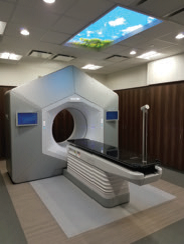With advanced technology, experts can customize treatment to a patient’s precise needs.
More than half of people with cancer receive radiation therapy—the use of high-energy beams to kill cancer cells and shrink tumors—as all or part of their treatment, according to the American Cancer Society.
With recent advances, the types of radiation therapy used can vary widely. “No two patients are treated alike,” says Alison Grann, MD, Chair of the Department of Radiation Oncology at The Cancer Center at Saint Barnabas Medical Center (SBMC), who heads a team of radiation oncologists, radiation therapists, physicists, dosimetrists and nurses.
“We provide individualized care based on the specific type of cancer, the size and location of the tumor and any preexisting conditions,” Dr. Grann says. “We’re quick to implement new standards of care that benefit patients, such as shorter radiation courses, and we have a large arsenal of technology to help us.”
With the latest technology, board-certified radiation oncologists at SBMC can treat all types of cancer—even hard-to-reach tumors—with pinpoint precision. In the past, normal tissue surrounding the site of the cancer was often damaged by radiation therapy. Now, with new therapies, experts can better target cancer cells directly—often in far less time than in the past.
NEW TREATMENTS
There are two main types of radiation therapy: external beam radiation and internal radiation.
External beam radiation therapy, the most common type, uses machines called linear accelerators to direct high-energy rays from the outside into a specific part of the body. They operate with a technique known as intensity-modulated radiation therapy (IMRT), which manipulates radiation beams so they conform to the shape of a tumor.

For certain cases, SBMC radiation oncologists may choose the Vision AlignRT system, which employs surface guided radiation therapy (SGRT), a technique that tracks the patient’s surface and movements in 3D. The resulting precise delivery of radiation provides protection for the heart during treatment for cancer in the left breast.
The CyberKnife Robotic Radiosurgery System is a noninvasive alternative to surgery for many types of tumors. It administers stereotactic body radiation therapy (SBRT), also known as stereotactic ablative radiotherapy (SABR), which delivers intense, highly focused doses of radiation to tumors but limits the dose to surrounding tissues. CyberKnife’s cutting-edge technology tracks tumors in real time with continual image guidance, adjusting for a patient’s breathing and movement.
“With other machines, we have to stop the beams to account for a patient’s respiration,” says Raquel Wagman, MD, a radiation oncologist at SBMC. “With this system, patients breathe normally while radiation continues to be delivered without interruption.”
“The CyberKnife uses a robotic arm that rotates around the patient,” says David Huang, MD, a radiation oncologist at SBMC who specializes in lung and head and neck cancers. “It delivers one beam at a time, taking X-rays every 15 seconds to make sure we’re on target.”
In addition to precision, CyberKnife offers a shorter treatment time, ranging from one to five sessions, depending on the cancer.
The newest machine in SBMC’s arsenal, the TrueBeam radiotherapy system, also delivers SBRT, but faster than other technologies can. With older linear accelerators, the standard time was 20 minutes per treatment. “With the TrueBeam, we can finish in one to one-anda- half minutes. We’re delivering the same treatment, but more accurately and in less time,” says Dr. Huang. TrueBeam treats cancer anywhere in the body, including the lungs, breasts, prostate and head and neck.
“We are fortunate at Saint Barnabas, as most facilities don’t have both TrueBeam and CyberKnife and the option of choosing which is best for the patient,” notes Dr. Grann.
INTERNAL OPTIONS
Internal radiation therapy, as the name implies, involves putting a source of radiation inside the patient’s body—for example, into a tumor or inside a cavity in the body, such as the uterus or rectum.
One method of internal radiation therapy is selective internal radiation therapy (SIRT), which uses tiny radioactive beads to control cancers in the liver. “Saint Barnabas is the first hospital in New Jersey to offer SIRT,” says Dr. Wagman. “With SIRT, we can target disease in the liver, reduce pain and delay progression.”
Dr. Wagman says her team has also seen excellent results with gynecologic cancers using brachytherapy, which involves placing a radioactive implant into cancerous areas. Patients can also opt to have anesthesia during the procedure—something standalone radiation therapy centers can’t offer.
Radiation oncologists at The Cancer Center continue to be leaders in the field of radiation. For example, Dr. Wagman is launching a program for neuroendocrine cancer using a new FDA-approved cancer medicine called Lutathera, which emits a small amount of radioactivity, in a joint effort between the Radiation Oncology and Nuclear Medicine departments. In addition, the partnership that RWJBarnabas Health and The Cancer Center have with Rutgers Cancer Institute of New Jersey, the state’s only NCI-Designated Comprehensive Cancer Center, gives radiation therapy patients access to the latest research and clinical trials
“We understand the latest research and the innovative technology that we can offer patients, but we also see each patient as an individual,” says Dr. Grann. “As a team, we will take the best possible care of each patient we see.”
To learn more about cancer treatment at Saint Barnabas Medical Center, visit www.rwjbh.org/beatcancer.